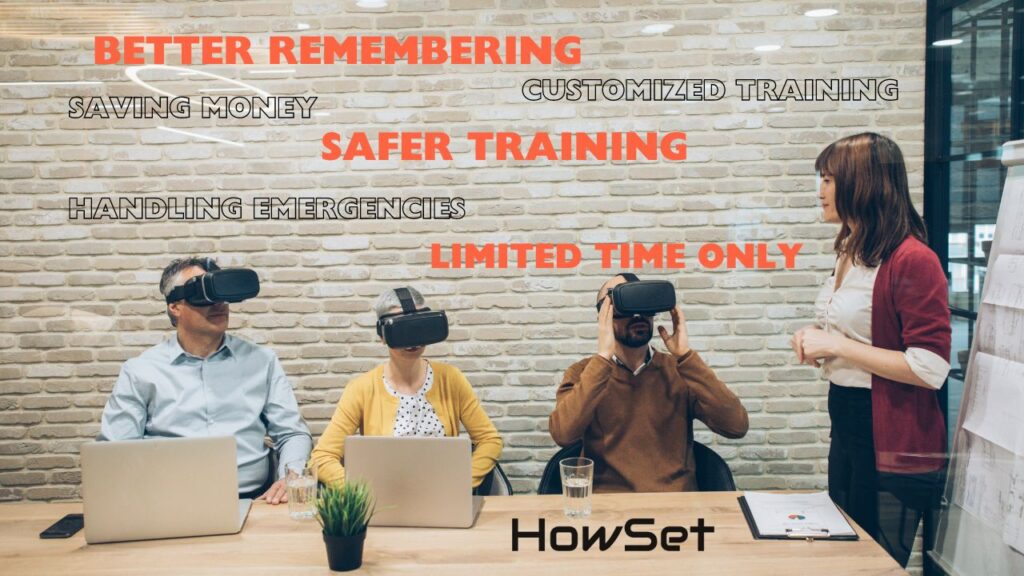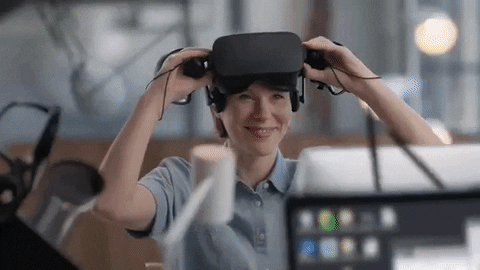Virtual Reality in Employee Training: A Simple Guide
In today’s fast-paced world, training employees effectively is key to success in any business. Virtual Reality (VR) has emerged as a powerful tool in this area. It’s not just a gadget for video games anymore. VR is changing how we train people at work. Imagine putting on a headset and stepping into a virtual world where you can learn new skills in a realistic setting. This is what VR offers in training.
In this guide, we’ll explore how VR is making a big difference in training employees. You’ll learn about its benefits, like saving time and money, and how it makes learning more interesting and memorable. We’ll also look at real examples from different industries where VR is already making training better and more effective.
VR training is not just a trend; it’s becoming a must-have in many fields. Whether you’re in healthcare, automotive, or any other industry, understanding VR’s role in training can give you an edge. So, let’s dive in and discover how VR is transforming the way we train our workforce.
Understanding Virtual Reality in Training

What Is Virtual Reality in Training?
Virtual Reality, or VR, is like stepping into a computer game where everything feels real. In training, VR puts you in a virtual world where you can practice job skills. It’s like a flight simulator for pilots, but for all kinds of jobs. You wear a headset, and suddenly, you’re in a different place, learning by doing. It’s more than just watching or reading; it’s about experiencing and practicing.
The Benefits of VR Training
- Real-Life Experience: VR creates a world that looks and feels like the real thing. You get to practice tasks as if you’re actually doing them.
- Safe Learning Environment: Make mistakes in VR without real-world risks. It’s safe to try and fail in this virtual space.
- Cost-Effective: Save money on physical materials and travel for training.
- Time-Saving: Learn faster because VR makes training more engaging and focused.
VR Training in Action
- Healthcare: Nurses and doctors practice surgeries and medical procedures without being in an actual operating room.
- Retail: Staff learn customer service skills by interacting with virtual customers.
- Manufacturing: Workers train on virtual machines, learning how to operate them safely before touching the real thing.
How VR Training Compares to Traditional Methods
| Feature | Traditional Training | VR Training |
|---|---|---|
| Setting | Classroom or On-Site | Virtual Environment |
| Interaction | Limited by Physical Constraints | Fully Interactive |
| Risk | Higher in hands-on tasks | Safe, Controlled Environment |
| Cost | Can be high (travel, materials) | Lower (virtual materials) |
| Engagement | Varies | High (immersive experience) |
| Flexibility | Scheduled, Fixed | Anytime, Anywhere |
Real Stories from VR Training
- A testimonial from a healthcare professional: “Using VR to practice surgeries has made me more confident in the operating room. It’s like I’ve done the procedure many times before I actually perform it on a patient.”
- Feedback from a retail manager: “Our staff’s customer service skills improved noticeably after VR training. They’re more prepared for real-life scenarios now.”
Visuals and Interactive Elements
- Images: Show photos of people using VR headsets for training.
- Bullet lists: Highlight key benefits and uses of VR in training.
- Table of comparison: Useful to show differences between traditional and VR training.
Understanding VR in training is about seeing its potential to make learning more effective, safe, and engaging. It’s a step into a future where we can practice and perfect our skills in a virtual world, preparing us better for the real one. Whether it’s in healthcare, retail, or any other field, VR is transforming how we train and learn.
Case Studies: VR in Action
Real-World Examples of VR Training
Let’s look at how different businesses use VR for training. These real-life examples show us how VR is changing the way people learn and work.
Automotive Industry: BMW and Audi
- BMW: They use VR to teach their staff about car design and safety. This helps employees learn in a realistic setting without needing actual cars.
- Audi: Audi’s VR program lets workers practice assembling car parts. It’s like a game where they learn by doing.
What They Achieved:
- Employees learned faster and made fewer mistakes.
- Training became more interesting and fun.
- They saved money on training materials and space.
Healthcare: Surgeon Training
- Surgeons are using VR to practice operations. They wear VR headsets and use tools that feel like real surgical instruments.
- This training helps them prepare for actual surgeries without any risk to patients.
Benefits Noticed:
- Surgeons felt more confident and ready.
- The chance of mistakes during real surgeries went down.
- Training time was shorter, but the learning was better.
Retail: Walmart
- Walmart uses VR to train staff for busy shopping days like Black Friday.
- Employees wear headsets and practice handling crowds and stressful situations.
Outcomes:
- Staff were better prepared for real-world challenges.
- They learned how to manage stress and customer service better.
- The training was more engaging than traditional methods.
Visuals and Interactive Elements
- Images: Photos of employees in different industries using VR headsets.
- Testimonials: Quotes from employees and trainers about their VR training experiences.
These case studies show us that VR isn’t just a futuristic idea. It’s here now, helping people in various industries learn better and work smarter. From car factories to operating rooms, VR is making training more effective and engaging. The success stories from BMW, Audi, and Walmart prove that VR can make a real difference in how we train for the jobs of today and tomorrow.
The Business Impact of VR Training

VR Training’s Effect on Companies
When businesses use VR for training, they see many good changes. It’s not just about using cool tech; it’s about real benefits that help the business grow and save money.
Cost Efficiency and Time Management
- Saving Money: VR cuts down costs on things like physical materials, travel for trainers, and renting training spaces.
- Saving Time: VR makes training quicker. Employees learn faster because they are more focused and engaged.
Improved Learning Outcomes
- Better Remembering: People remember what they learn in VR better because they ‘do’ and ‘see’ things, not just hear or read.
- Customized Training: Each employee can get training that fits their needs. VR can adapt to different learning styles.
Safety and Risk Management
- Safer Training: Risky jobs like operating heavy machinery can be practiced safely in VR.
- Handling Emergencies: VR lets employees practice how to act in emergencies without real danger.
How VR Affects Business: A Closer Look
- Businesses that use VR for training often see better results from their staff.
- Employees feel more confident and prepared for their jobs.
- Companies save money and time on training, which can be used for other important things.
Real Comments from Businesses
- A company manager says: “Since we started using VR for training, we’ve seen fewer accidents and better performance from our team.”
- An HR professional notes: “VR training has been a game-changer for us. It’s more effective and employees are more engaged.”
Visuals and Interactive Elements
- Bullet Lists: Summarize key benefits of VR training for businesses.
- Images: Show before-and-after scenarios of training rooms with and without VR.
- Testimonials: Include quotes from business leaders who have seen the impact of VR training.
VR training is more than just a new way to teach skills. It’s a tool that brings real business benefits like saving money, time, and improving safety. Companies across different sectors are finding that VR training is an investment that pays off by making their workforce more skilled, efficient, and prepared. This positive impact is why more and more businesses are turning to VR as a key part of their training programs.
Challenges and Considerations
Understanding the Obstacles of VR Training
Even though VR training is a great tool, it’s not always easy to use. There are some challenges that businesses need to think about before they start.
Technological and Budget Constraints
First, VR needs special technology like headsets and computers, which not every business has. Also, starting VR training can be costly. This might be hard for smaller businesses because of the money needed at the beginning.
Cultural and Organizational Adaptation
Another challenge is getting used to the change. Some employees and managers might not want to switch to VR. They might like the old way of training better. Plus, the people who teach the employees have to learn about VR too. This can take extra time and training.
A Closer Look at the Challenges
Setting up VR training can be tricky. The cost at the start can be a big step for a business. Also, it can be hard to get everyone to agree to use VR. Especially in places where they always did training the old way.
Real Experiences with VR Challenges
A small business owner said, “We were excited about VR training, but it cost more than we thought at the start.” A training manager shared, “It took a while for our trainers to get used to the new VR technology.”
Using VR for training is a big move. Knowing about challenges like money and getting used to new things is important. Even though there are hard parts, the good things about VR training can make up for them over time. If a business plans well and is ready for these challenges, they can really benefit from what VR training offers.
Future of VR in Workforce Training

What’s Next for VR in Training?
VR is becoming more popular in training, and it looks like it will keep growing. Let’s think about what the future of VR training might look like.
Innovations on the Horizon
Technology keeps getting better, and VR is no different. In the future, VR headsets might be lighter and easier to use. Also, the virtual worlds in training could become even more realistic. This means employees can learn in a way that’s very close to real life. We might also see VR combining with other technologies like artificial intelligence (AI) to make training even smarter.
Preparing for a VR-Driven Training Future
For businesses looking to use VR, it’s important to start planning now. This means thinking about the costs, the kind of training they need, and getting their team ready for this new way of learning. It’s also a good idea to keep an eye on new VR technologies and think about how they can be used in training.
A Glimpse into Tomorrow
The future of VR in training is exciting. We might see things like virtual trainers powered by AI or VR programs that can change based on how the user learns. This could make training with VR even more effective.
Real Predictions for VR Training
A tech expert said, “In the future, VR training will be more common, like how we use computers in the office today.” This shows how big VR could become in the world of training.
The future of VR in workforce training is full of possibilities. With new technology on the way, VR training will keep getting better and more useful. Businesses that start using VR now will be ahead of the game. They will be ready to take full advantage of all the new and exciting changes that are coming.
Conclusion
Virtual Reality (VR) is transforming the landscape of workforce training, offering innovative and effective ways to enhance learning and skill development. From its practical application across various industries to its ability to create safe and engaging learning environments, VR stands as a powerful tool in modern training programs. Despite facing initial challenges like technological requirements and budget constraints, the benefits of VR, such as cost efficiency, improved learning outcomes, and risk management, are undeniable. Looking ahead, the future of VR in training is bright, with potential advancements making it an integral part of employee development. Businesses embracing this technology now are setting themselves up for success in an increasingly digital world.


Leave a Reply